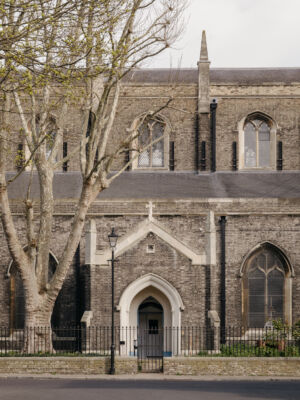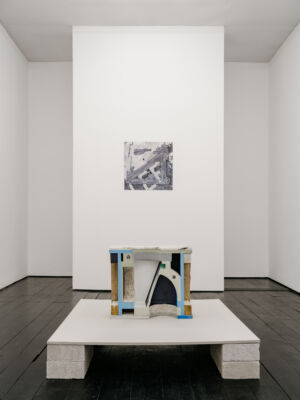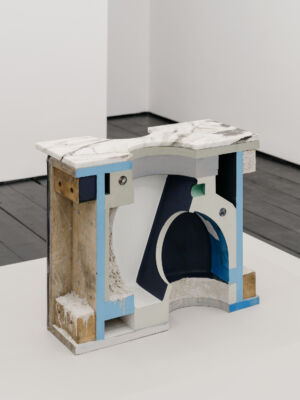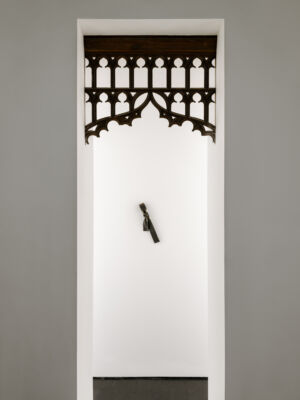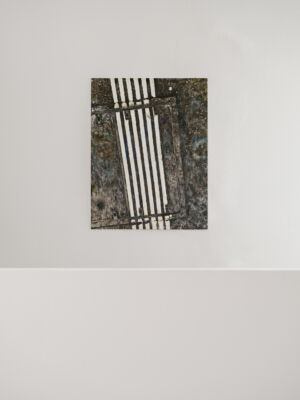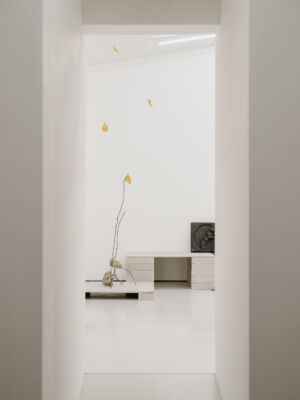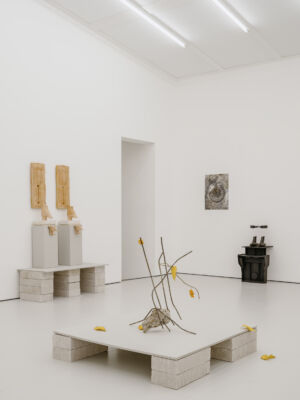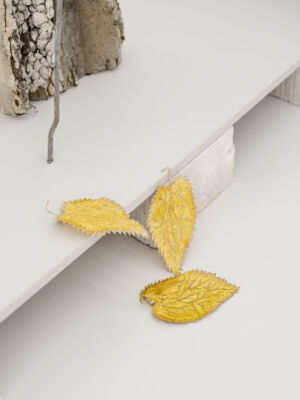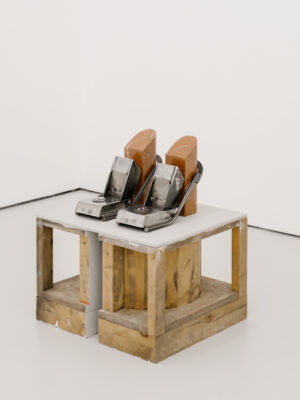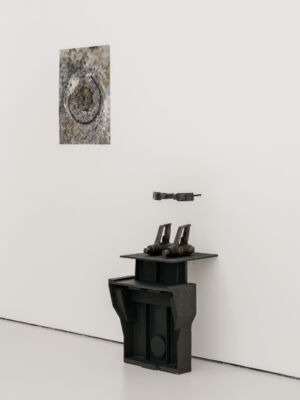Molly Grad
‘Invisible modes’
Curated by Jenn Ellis
April 11th – April 28th, 2025. The Florence Trust, Holy Trinity, Cloudesley Square, London N1 0HN
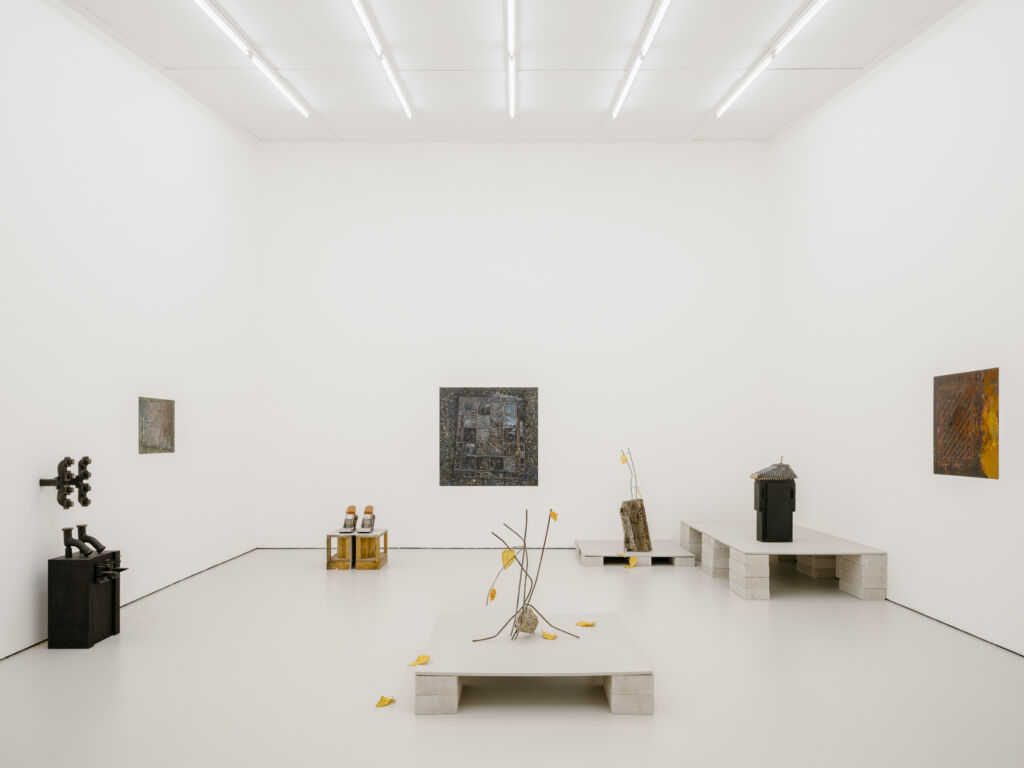
Molly Grad, installation view ‘Invisible modes’, 2025. The Florence Trust. Photography by James Retief.
What are the systems of operation and actuality, the items and conditions, that are not seen, concealed? Fantasmic, ostracised – our eyes, beings and minds are programmed to ignore, consciously or unconsciously, certain everyday realities. From the manhole covers we step on and over, to the workers on our streets, roads and buildings – there is an innate verticality to what we assimilate and ingest, a pitted prioritisation of knowledge, information and experience. ‘Invisible modes’, a solo show by Molly Grad at the Florence Trust, curated by Jenn Ellis and presented by Apsara Studio, addresses across multiple mediums in various rooms of a converted grade-listed church in Islington, these edited perceptions. Across documented performance, installation, sculpture and painting, Grad poses an engaging and subtly affronting questioning of the ‘high-low’ paradigm, shifting sight, observation and experience to reflect on architectural and societal structures.
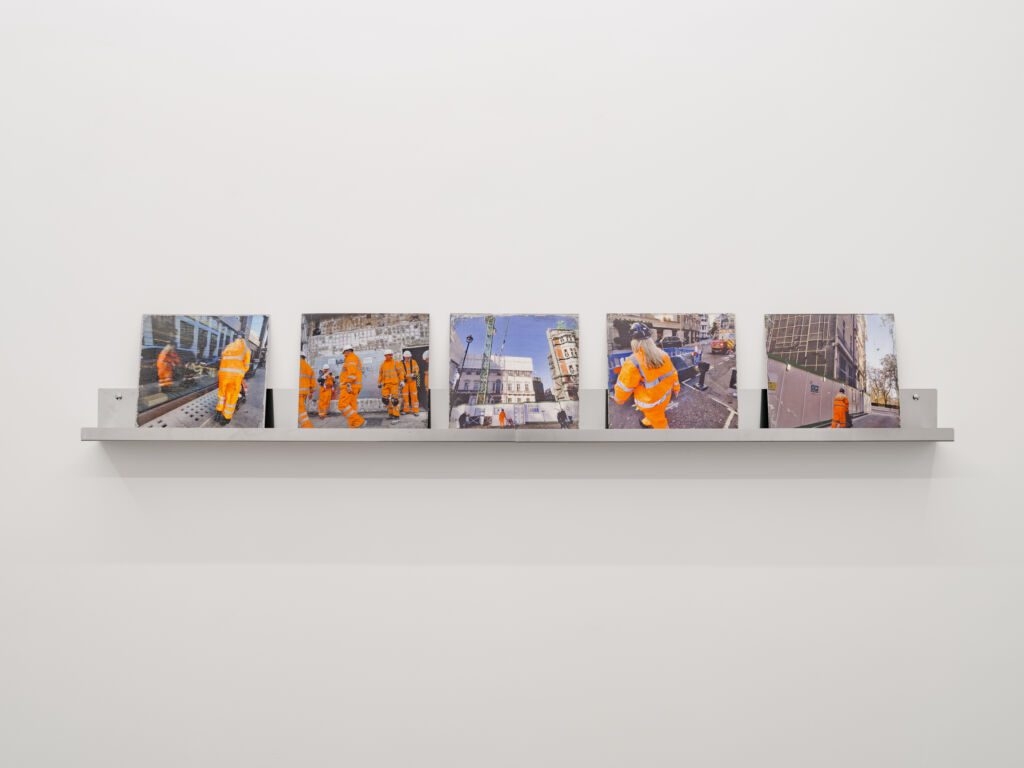
Molly Grad, installation view ‘Invisible modes’, 2025. The Florence Trust. Photography by James Retief.
At the root of Grad’s practice is an emphasis on performance in a manner that is deeply personal versus audience-led. In her research and writing, she’s turned to the unheard stories of ballet dancers, such as Balanchine’s manipulated entourage, over to the physical conditions of past family members to extract considerations of what is seen, held, applauded. There is a profound sense of the “concealed” body, how it moves, what it holds. Equally, as a woman and mother: the added complexities of internal systems, childbirth, the ways in which what we’ve been biologically given are meant to serve society. Flanked on either side of the first room in ‘Invisible modes’ are a series of ten steel plates, five on each side – each capture an intervention, by Grad, into an urban construction site. Banal, everyday sites for city dwellers, Grad dons a high-visibility suit and takes to their ranks, at times alone, on other occasions with her young child. Documented photographically, she prints these onto steel plates, the materials of such locations, and accompanies them with notes of observation. As visitors, Grad invites us to pick up these plates, handle them, as if they were portals or part of an urban visual library, and discover the where, when, how and what – diaristic remarks surrounding the irony of tonal visibility shielded with prejudiced concealment.

Molly Grad, installation view ‘Invisible modes’, 2025. The Florence Trust. Photography by James Retief.
In conversation with these documental portals is a singular painting, at the centre, of a manhole cover. A recurring thematic focus in Grad’s work, these dark entities, vertically hung as opposed to horizontally encountered, painted on steel, are systematically transformed by virtue of Grad’s detailed strokes. The first of several works from this series encountered in ‘Invisible modes’, California Snow, 2024 shows a quadrangular cover, partially concealed by white elements. Snow akin to smeared paint, there is an abstract quality to the painting, as if Grad is highlighting the aesthetic possibilities of an otherwise overlooked and trodden upon quotidian element. Described by Grad as “sites of occurrence”, there is equally a personal association with these depictions. Grad reflects on the parallels that can be drawn between these civic incursions and womanhood as well as other communities across gender, ethnicity, and orientation, probing the tropes of what is visible, what is seen, what is acknowledged and what is valued. In the centre of the first room is additionally a sculpture, Coffee Table I, 2025 made of marble, concrete, wood and pavement-like, canvas patchwork back. A mix of societally-regarded high to low elements, conjured into a form with a title that references an everyday domestic object, Grad extends the questioning of what in our immediate surroundings is used and relied upon without being necessarily acknowledged or credited.
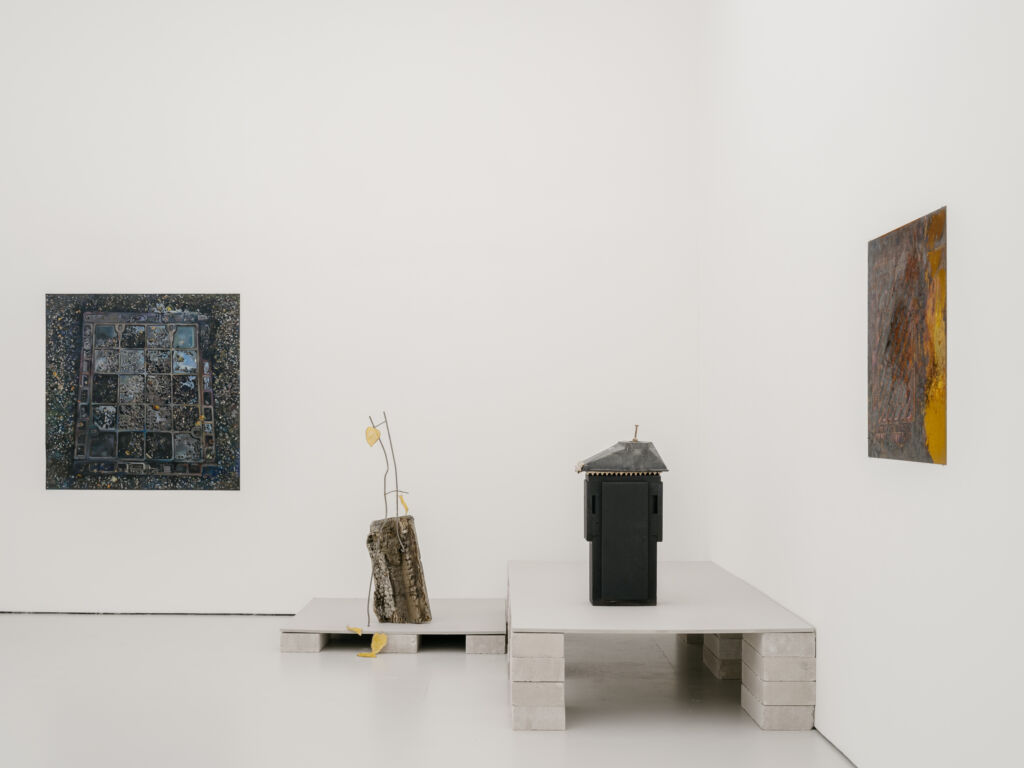
Molly Grad, installation view ‘Invisible modes’, 2025. The Florence Trust. Photography by James Retief.
Transitioning to the second main space, visitors encounter a passage area – an in-between – which in a way evokes those non-places that Grad is highlighting, investigating and even collaborating with. Here we encounter a knotted ribbon, Gros-Grain, 2025, looped in itself, hanging from a back wall. With a background in fashion design, Grad previously used Gros-Grain in luxury garments; here, however, it is a fragment, frozen in time. Patinated black, and brushed subtly to expose the gold beneath the surface, the idiosyncratic tonal language of building sites is appropriated and highlighted, subverting its original use. In tandem, visitors start to hear the sound of a track: recordings that Grad has been collecting, emanating from gallery two. Stepping into this voluminous space, visitors are invited to ambulate amid a selection of sculptures with incorporated plinths and paintings; elevated on MDF and brick platforms, there is a nod and reminiscence of site work. Several paintings from Grad’s manhole series populate the walls, striking conversations with several plinth and wall-based sculptures across an array of mediums from cast bronze to found metal to stitched cloth.
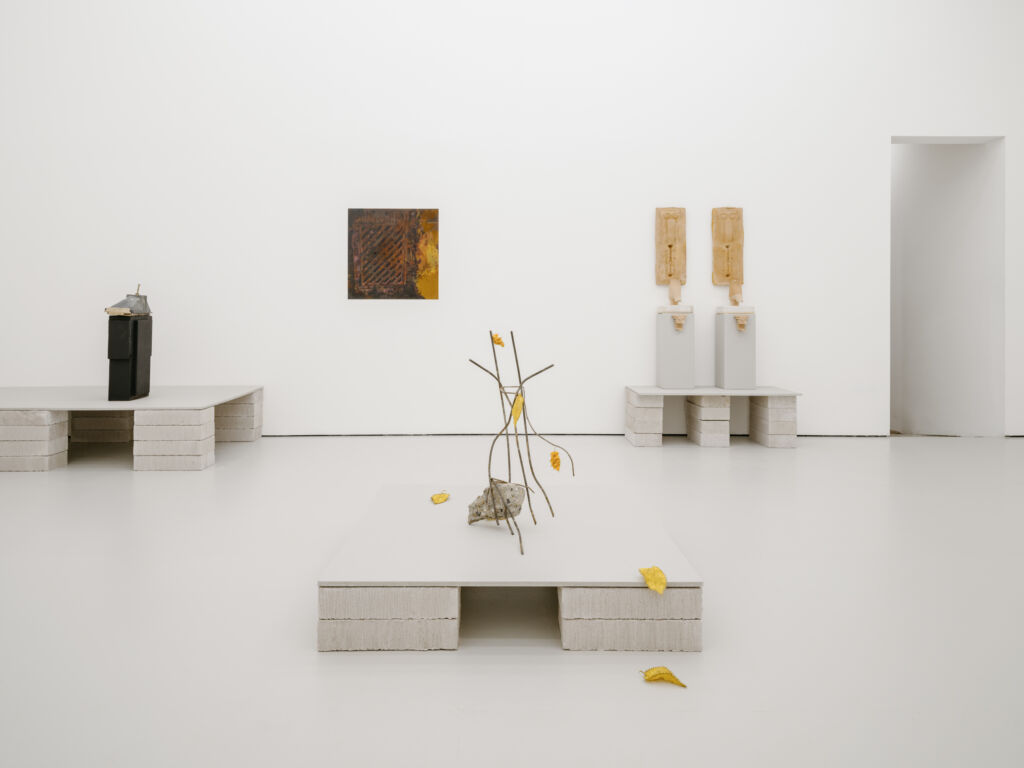
Molly Grad, installation view ‘Invisible modes’, 2025. The Florence Trust. Photography by James Retief.
Casting a particular focus on the body is a series of bronze and cast sculptures such as Aerobic Digestion I & II, 2022, Gladiators, 2023 and Phantom Limbs, 2025. Introducing the recurring motif of shoewear in Gladiators, Grad investigates their reading as a form of armour and armature. Equally though, she contemplates how they carry us and hold us, acting as forms of protection but also contact with the trodden ground. These objects relate on the one hand to Grad’s past professional life but also defy it – subverting an item of embellishment as one of strength and resistance. Made of bronze and at times marble, in the case of Footlocker, 2025, their materiality speaks to enduring tenacity. This is balanced with a certain delicacy, as in the case of Phantom Limbs, 2025 where the finish, in a near terracotta, makes us think of centuries-old traditions of excavated vessels, clayware, holding, nurturing.
Oscillating over to the natural world, but also that of found elements and integrated debris, are works such as The yellow mulberry tree, 2023, Architrave, 2024, and Acacia, 2024. Made of found concrete, metal rods and delicately stitched silk leaves and crystal, embellished fruit, there is a nod to growth and creation amidst the urban detritus. Grad as such creates a sensitive nod to the shared properties between elements we pass by and over everyday, contrasting a manhole cover or discarded trash on the side of the streets, with delicate growth – are those desolate or hold a new beginning?
Ultimately, ‘Invisible modes’ is an exhibition but also an act of paying attention. Telling the stories that are hidden and inverting them. A moment to have them air, and by doing so, enact change.
In conversation with Molly Grad
‘I’m drawn to the environment that surrounds me and to working with it in order to create scenes that question what it is we perceive.’
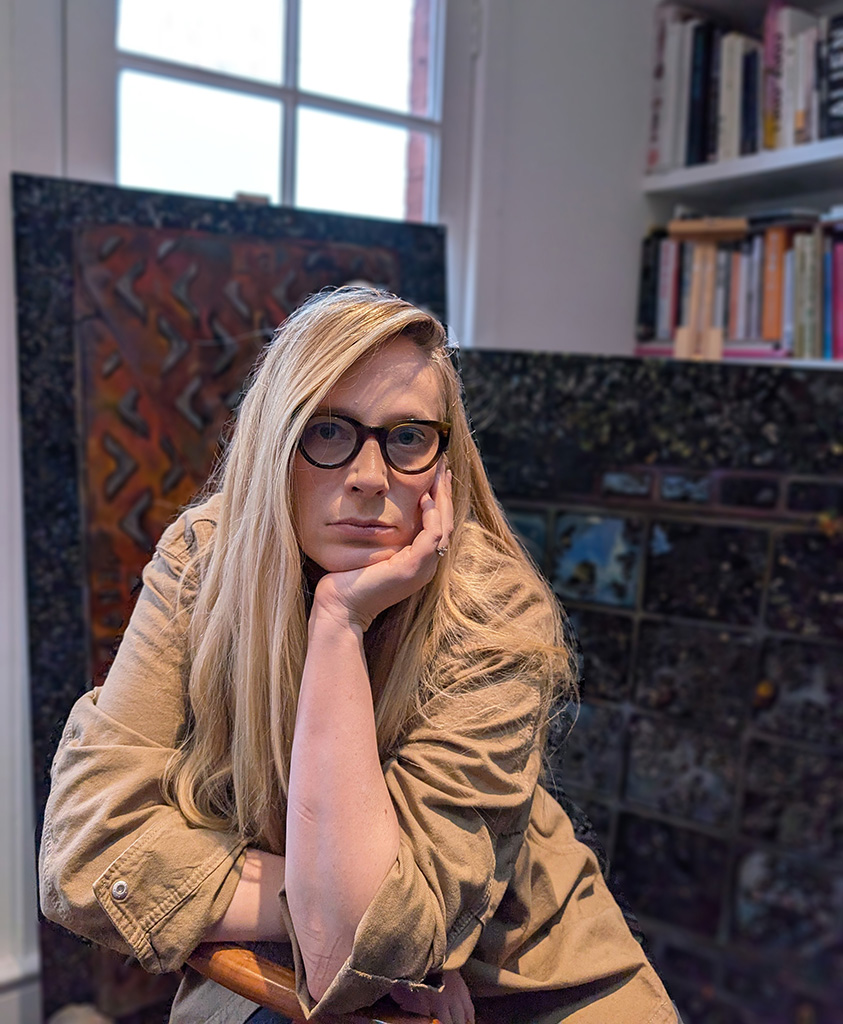
Molly, could you tell us about what you will be presenting in this new show titled ‘Invisible modes’?
The show contains a selection of my most recent works, a combination of sculptures, paintings and a few prints of my interventions over the last few years. They will be shown alongside a soundscape that follows along with the works, weaving together themes I have been working on in past years.
Talk to us about your background as a fashion designer. For more than 20 years, you have designed for leading fashion brands and celebrities, and your illustrations have been featured in specialist publications. We would love to hear how your experience in the fashion industry has influenced your shift into contemporary art?
First and foremost, I’ve decided to leave the Fashion industry due to Ecological urgency. I do not believe anyone needs this much product, and I felt I have more important things to contribute: to urgent debates, equality, matters discarded and rediscovered.
The craft of making clothes and cloth is something I’m still in love with however I’ve never cared for trends much – whether the garments I’ve designed previously or the art I am making now, I believe in timeless rather than timed. I have always been an artist that expresses and manifests through materials, and am fascinated by challenging form. In that sense I’m still working in the same way – I’m working with a vast array of materials, questioning and re-thinking shape and materials whilst forming outer shells – at the moment, out of an active choice I didn’t wish to objectify the female body, so in the last few years I’ve been deducting the female body and working with what is left. My paintings have a symbolism that points to a lack of body, and I aim at conveying an underlying presence. My sculptures in the show are different iterations of feet and shoes – and I work with textiles within the urban realm with techniques that are reminiscent of corseting and ribbon.
In your practice, you are drawn to ideas of visibility, empathy, and societal neglect through the creation of street sculptures and public interventions. You use the term “Corseting Concrete” to describe a labor-intensive process involving repetitive physical movements across a public space. We are interested to know how this process informs your work both practically and conceptually.
The question of invisibility and labour is woven through the work. Female labour. I try to make un-subtle pieces at times, at other times teetering on the brink of the absurd, as I feel there’s an urgency to see and feel what certain members of the public are going through. Our cities are built with a narrative of binary male wellness. Other spaces, people, labour are usually taken out of the equation – our streets are awash with high vis clad men we edit out of our vision, derelict and obsolescent systems we plug into and do not acknowledge. I connect with those systems and scenarios as allegory to different states of disrepair within our day today and a hope to begin a seeding process of working with what we have.
… and how does the public’s interaction with your work shape its meaning?
I think the solutions are present within our every day. listening, seeing and understanding everything around us, whether if alive or inanimate objects and surrounding. am very aware that places we perceive to be nature are not. They are layers of condensed debris, a sandwich of sediments, petro chemicals and condensed trauma that are coated in grass and called a park.. The urban sphere is a layer cake of damage we have all created, and we need to work with what we have rather than creating more fresh damage.
I’m drawn to the environment that surrounds me and to working with it in order to create scenes that question what it is we perceive. I research places, histories and materials and work to transform processes and generate moments that are fleeting but hopefully remain in our memory. Within the work I encounter members of the public and they inform the work – They can take the work to a different direction and this constantly changes and remains a surprise.
Your work seems to move freely between an eclectic mix of materials — silk, concrete, rubber, marble… What do these material choices reveal about the internal tension between durability, and decay, and how do they embody the theme of ‘invisibility’ that runs through your work?
These contrasts and compositions create a tension that speaks volumes about our hierarchies of materials, people, places. There are unconscious biases strewn within everyone’s perception and I like the work to ask those questions rather than answering them. Is silk really the most precious fibre? I like taking them out of context and re-position their use or make them useless whilst elevating something that is perceived as discarded, unwanted. These contrasts bring about many questions for me.
Finally, Molly, what do you hope the audience takes away from this emotional, artistic, and societal journey you’re sharing with us in this show?
I leave that question up to them. All I can do is make the work and hope it creates resonance that seeds something within people who encounter it.
Thank you so much, Molly!
Molly Grad is an interdisciplinary artist and writer, working across sculpture, painting, textiles, and public interventions. Her practice seeks out hidden histories and marginalised experiences in order to explore redemptive modes of expression. Grad’s work is fuelled by concerns around the social and environmental responsibilities attached to acts of creation and creativity, interests that sit at the confluence of her current and previous identities as an Artist-Parent with a young child and with an extensive background in the luxury fashion industry. Grad’s public interventions, or fleeting street sculptures, sit at the core of her practice. They involve a labour-intensive process which she describes as “corseting concrete”, requiring hours of repetitive physical movements across a public space as the artist threads soft brightly coloured fabrics through the crevices of neglected urban environments – a gesture intended to insist on visibility and to act as a catalyst for creating greater social awareness for society’s so-called invisibles, from mothers to construction workers. Through the process of creating the work, Grad comes into contact with members of the public, prompting organic conversations about consumer culture, identity and visibility. Grad will embark on her practice led Ph.D at the Royal college of art this September. She holds a Master of research degree in arts and humanities in the Royal College of Art, and is a past alumna of Central Saint Martins, London, Grad completed both her MA and BA degrees in fashion design. For twenty years, Grad worked as a designer for brands such as Stella McCartney and Yves Saint Laurent as well as designing costumes for artists and filmmakers such as Beyoncé and Martin Scorsese. Since leaving the fashion industry in 2019, Grad turned to art out of an interest in upending social hierarchies.
